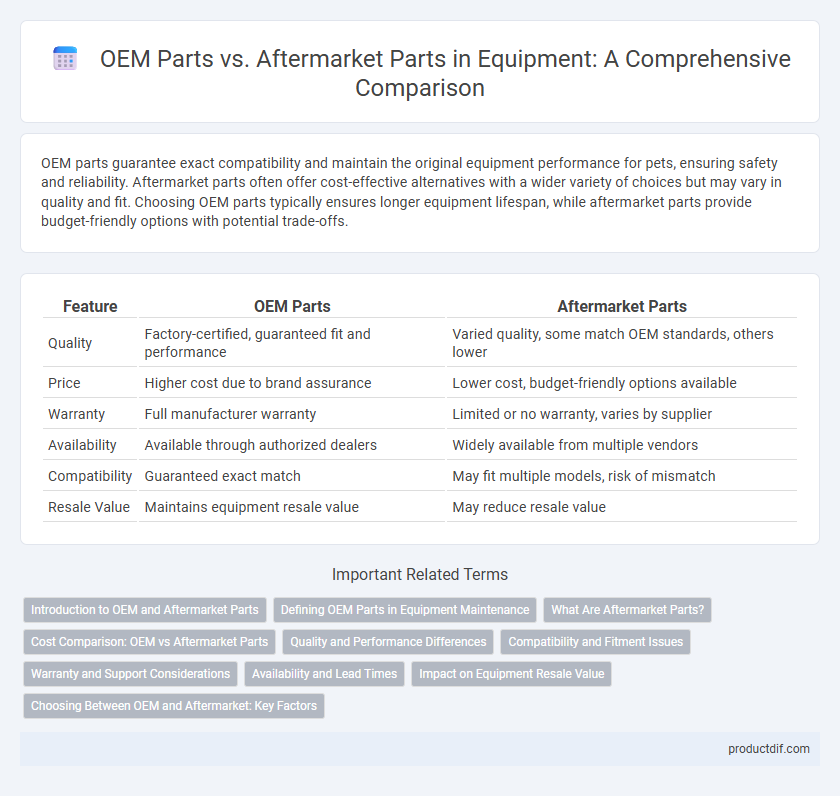OEM parts guarantee exact compatibility and maintain the original equipment performance for pets, ensuring safety and reliability. Aftermarket parts often offer cost-effective alternatives with a wider variety of choices but may vary in quality and fit. Choosing OEM parts typically ensures longer equipment lifespan, while aftermarket parts provide budget-friendly options with potential trade-offs.
Table of Comparison
| Feature | OEM Parts | Aftermarket Parts |
|---|---|---|
| Quality | Factory-certified, guaranteed fit and performance | Varied quality, some match OEM standards, others lower |
| Price | Higher cost due to brand assurance | Lower cost, budget-friendly options available |
| Warranty | Full manufacturer warranty | Limited or no warranty, varies by supplier |
| Availability | Available through authorized dealers | Widely available from multiple vendors |
| Compatibility | Guaranteed exact match | May fit multiple models, risk of mismatch |
| Resale Value | Maintains equipment resale value | May reduce resale value |
Introduction to OEM and Aftermarket Parts
OEM parts are components manufactured by the original equipment maker, ensuring exact specifications and compatibility with the equipment. Aftermarket parts are produced by third-party companies and often offer more cost-effective options with varying quality standards. Choosing between OEM and aftermarket parts depends on the balance of price, warranty, and performance requirements for the specific equipment.
Defining OEM Parts in Equipment Maintenance
OEM parts in equipment maintenance refer to components produced by the original manufacturer of the equipment, ensuring full compatibility and adherence to the exact specifications used in the initial assembly. These parts typically guarantee optimal performance, reliability, and maintain manufacturer warranties, making them a preferred choice for maintaining equipment integrity. Using OEM parts minimizes the risk of malfunction and prolongs equipment lifespan, vital for operational efficiency in industrial applications.
What Are Aftermarket Parts?
Aftermarket parts are components produced by manufacturers other than the original equipment manufacturer (OEM), designed to fit and function like OEM parts but often at a lower cost. These parts cater to a wide range of equipment models and provide increased availability and variety, often including enhancements or modifications not found in OEM versions. Quality and compatibility can vary, so selecting reputable aftermarket suppliers is crucial to ensure equipment performance and safety.
Cost Comparison: OEM vs Aftermarket Parts
OEM parts generally have a higher initial cost due to brand-specific manufacturing standards and guaranteed compatibility with original equipment. Aftermarket parts offer a cost-effective alternative, often priced 20-50% lower, but quality and longevity can vary widely depending on the manufacturer. Selecting between OEM and aftermarket components requires balancing upfront expenses with potential long-term maintenance and performance outcomes.
Quality and Performance Differences
OEM parts guarantee precise compatibility and adherence to manufacturer specifications, ensuring optimal equipment performance and reliability. Aftermarket parts vary widely in quality, with some offering comparable performance at a lower cost, while others may compromise durability and fit. Choosing OEM parts is crucial for maintaining equipment warranties and long-term functionality, whereas aftermarket options can be suitable for budget-conscious repairs if quality standards are verified.
Compatibility and Fitment Issues
OEM parts guarantee precise compatibility and exact fitment as they are designed and manufactured by the original equipment manufacturer, ensuring seamless integration with the intended equipment model. Aftermarket parts may offer cost savings but often face variability in compatibility and fit, leading to potential installation challenges or suboptimal performance. Ensuring part numbers and specifications match the equipment model is critical when opting for aftermarket alternatives to avoid functional discrepancies.
Warranty and Support Considerations
OEM parts typically come with comprehensive manufacturer warranties and dedicated support, ensuring compatibility and reliability in equipment repair. Aftermarket parts may offer limited or variable warranty coverage, often lacking the direct backing of the original equipment manufacturer. Choosing OEM parts can reduce maintenance risks and provide consistent technical support crucial for preserving equipment performance and warranty validity.
Availability and Lead Times
OEM parts typically offer limited availability due to manufacturer-specific supply chains, resulting in longer lead times compared to aftermarket parts. Aftermarket parts benefit from wider distribution networks and multiple suppliers, enabling faster procurement and reduced downtime. This increased availability and shorter lead time make aftermarket parts a preferred choice for urgent equipment repairs.
Impact on Equipment Resale Value
OEM parts maintain equipment resale value by ensuring compatibility and preserving manufacturer warranties, which appeals to buyers prioritizing reliability and original specifications. Aftermarket parts may offer cost savings but can lead to uncertainty about quality and potential voided warranties, negatively affecting resale value. Buyers often perceive equipment with OEM parts as better maintained, resulting in higher resale prices.
Choosing Between OEM and Aftermarket: Key Factors
Choosing between OEM and aftermarket parts hinges on factors such as cost, quality, and compatibility with existing equipment. OEM parts provide guaranteed fit and manufacturer warranty, ensuring optimal performance and reliability, while aftermarket parts often offer a more affordable option with varying quality and availability. Assessing the specific equipment requirements and long-term maintenance goals is crucial for making an informed decision.
OEM parts vs Aftermarket parts Infographic

 productdif.com
productdif.com